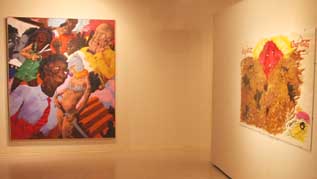
|
||
|
Portland art blog + news + exhibition reviews + galleries + contemporary northwest art
|
||
Robert Colescott at Laura Russo Gallery  Robert Colescott's Haircut 1989 (left) Artworks are judged in many ways but one of them, the ability to remain fresh, emblematic or poignant after standing the test of time seems to trump all of the others. Happily, time has not blunted the sting of Robert Colescott's irreverent and boldly direct work. Robert Colescott, a onetime Portlander, seems to be one of the few contemporary artists capable of achieving that feat, maybe because so many of today's young whippersnappers like Cecily Brown, Inka Essenhigh, Kara Walker, Daniel Richter or even cartoons like The Family Guy seem to be following in his iconoclastic "equal opportunity offender" footsteps. As the 1997 Venice Biennale representative for the US he took shots at everyone, whites, blacks, construction workers, salesmen, Coca Cola, sex and the priesthood etc. Sometimes he took on all of these subects at once. Colescott creates a kind of pantheon of human failings and there are no "sacred cows" for Colescott (though I grew up amazed by the sheer ferocity of a painting with that very title at The Milwaukee Art Museum). Back in 1989, being an overeducated upper middle class gypsy+barbarian+blue-blooded mutt white boy I appreciated how he sycretically laid it out in vibrant, isn't the world weird colors while referencing old sacred friezes in Europe. Then I realized those friezes had their roots in Egyptian and Assyrian art. It all suddenly made sense; contemporary art was about the disorder of the present while often referencing forms that implied order and authority in the past. Now Figurative painting is big again but artists like John Currin and Inka Essenhigh are still relatively pleasant conversationalists compared to Colescott.  Haircut (detail) 1989 The show on view through tomorrow is a museum level survey of his late 80's and early 90's output leading off with 1989's Haircut. It's a sumptuous painting, though nary an inch of it is flattering. The nearly full length figure, a blond woman in a helmet and armored brazier is surrounded by people's faces. Is she Justice? Some of the faces are nicely coifed office workers others are being held a gunpoint or lounging back smoking a big cigar. The words; angel, capitalist, boss, worker and slave are written on the canvas as well. All but "angel" are written on a series of steps. Sure this is a caricature, but it's a caricature of the work place power dynamics that still exist today. The message is, don't stand out fit in and America is still an essentially puritanical country which ads a sinister homogenizing tint to the great American melting pot. Instead of cosmopolitanism, a kind of puritanical, waspish suburbanism still reigns. Other large paintings like the Judgement Of Paris and At The Bathers's Pool: Apparition of Venus both mock and pay tribute to the European old master allegories as well.  All Roads Lead to Rome (1995) Works on paper like Sepic River Stay Away From the Door or Light Opera are even more brash than the canvases. All Roads Lead To Rome seems particularly poignant as the central black is brutally stabbed surrounded by words like "would not" and "not me". It makes me wonder about America's current political situation with a very unpopular president. I constantly hear people say, "I didn't vote for him." Ok fair, but have Americans really demanded strong leaders since Clinton? People like Gore, Kerry and Bush are hardly new blood and when it has arisen, in the form of John McCain and Howard Dean the Republican and Democratic Parties have both pulled off their own Et tu, Brute? moments. It makes Dana Schutz look tame even though I like her and her work. Other Paintings like Oil Man, where Lady L (Liberty?) is bound and gagged in a chair seem completely current as well.  Oil Man 1990 (Left) & At The Bathers's Pool: Apparition of Venus 1984 (Right) Though Colescott can be shrill there is evenhandedness about his satire and my favorite work in the show is A Fool There Was Europe - Africa from 1992. The swirling black red cloud of groping humans is in the shape of the continent. Is it about aids, overpopulation, the slave trade, colonialism, diamond trades, and genocide. Sure and though the painting is from 1992 it seems like nothing has changed. Currently Colescott is taken for granted and in most major museum's collections. He is America's Jorg Immendorf, and if anything he's the painterly conscience we as a country so desperately need. He is America's greatest living societal painter. Last day of show: Dec 23rd 2006 Posted by Jeff Jahn on December 22, 2006 at 11:50 | Comments (0) Comments Post a comment Thanks for signing in, . Now you can comment. (sign out)
(If you haven't left a comment here before, you may need to be approved by
the site owner before your comment will appear. Until then, it won't appear
on the entry. Thanks for waiting.)
|
| s p o n s o r s |
 |
 |
 |
 |
 |
 |
 |
 |
 |
 |
 |
 |
 |
 |
 |
 |

|
Site Design: Jennifer Armbrust | • | Site Development: Philippe Blanc & Katherine Bovee | |

